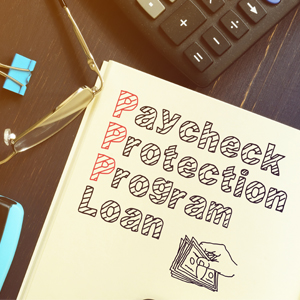Now About That Loan Forgiveness

New rules apply after a June 5 law was passed in Congress that extends the covered period to December 31, 2020, and also relaxes some other criteria.
The Paycheck Protection Program (PPP) Loan was one of the most popular government assistance initiatives to come out of the Covid-19 crisis. Many, if not most, eligible businesses obtained a PPP Loan to help them during the initial months of the lockdown. This low-interest, forgivable loan for businesses with 500 employees or less was designed to help businesses maintain their payroll during the COVID-19 crisis. Clearly, the main reason for the loan’s popularity was the eventual forgiveness. Now that the forgiveness applications are available and being submitted, there are many factors that must be considered in order to receive partial or full forgiveness on this loan. Additionally, on June 5, 2020, an amendment was signed into law which extended the covered period and reduced the percentage that must be used for payroll costs. Note that the SBA has and continues to issue new guidance related to these loans.
Loan Forgiveness Based on the Utilization of the Loan
The maximum loan amount provided was 2.5 times a borrower’s monthly payroll costs. The maximum amount of loan forgiveness is determined based on how the loan was used during an eight week (56 day) period, if the PPP Loan was obtained before June 5, 2020, or during a twenty-four week period or December 31, 2020, whichever is earlier, referred to as the “covered period”. This covered period either begins at the time of the PPP Loan disbursement OR at the time of the borrower’s first pay period following the disbursement. The loan may be forgiven only if utilized for certain eligible payroll and non-payroll expenditures during the applicable covered period.
1. Eligible Payroll Costs
a. You can be eligible for forgiveness for payroll costs incurred during the “covered period”. Acceptable payroll costs include compensation (not exceeding $100,000 annually for any employee), employer contributions for employee group health care coverage, employer contribution for employee retirement plans, and payment of employee’s state and local taxes assessed on compensation.
2. Eligible Non-payroll Costs
a. You can also be eligible for forgiveness for non-payroll costs incurred during this “covered period”. Such expenditures must be related to the business or business properties and include mortgage interest payments, rent or lease payments, or utilities like electricity, gas, water, transportation, telephone, internet, etc. Be sure to note that all debts, rental/ lease and service agreements must have begun prior to February 15, 2020 in order to be eligible for forgiveness under the PPP Loan. Additionally, non-payroll expenditures cannot exceed more than 40% of the PPP Loan forgiveness.
At least 60% of the PPP Loan must be utilized for Payroll Costs for full forgiveness of the loan.
Reduced Salaries for Employees
Employers who reduced salaries during the “covered period” may not be eligible for full PPP Loan forgiveness. Specifically, any reduction in aggregate average pay of employees by more than 25% based on the average pay from January 1 through March 31, 2020, will have their loan forgiveness amount reduced. However, employers can avoid this reduction if they restore the employee’s average pay to equal or greater value by December 31, 2020. It is important to note that employers do not need to maintain the same individual employees, only the average pay of all employees.
Loan Forgiveness Based on Number of Employees
Borrowers may see a reduction in PPP Loan forgiveness if they reduce the number of full-time equivalent employees during the “covered period”. However, borrowers have the opportunity to choose between three different comparison periods to show their base number of full-time equivalent employees. The three periods are
• February 15, 2019 to June 30, 2019
• January 1, 2020 to February 29, 2020
• In the case of a seasonal employer, a consecutive 12-week period between May 1, 2019 and September 15, 2019.
Exceptions for reductions in forgiveness due to loss of employees include:
• The borrowers have made a good-faith, written offer to rehire the employee during the “covered period” and the employee has given a documented rejection to such offer
• The employee was fired for cause
• The employee voluntarily resigned
• The employee voluntarily asked for a reduction in hours
Documentation Needed for PPP Loan Forgiveness Application
When applying for forgiveness, borrowers will be required to submit documentation with their applications.
For payroll documents:
• Bank account statements
• Tax forms for the “covered period” reporting on payroll tax filings, state quarterly wage reporting, and unemployment insurance tax filings
• Payment receipts, cancelled checks, or account statements showing employer’s payments to employee health insurance and retirement plan.
For non-payroll documents:
• Business mortgage interest payments for “covered period”
• Business rent and lease payments for “covered period”
• Business utility payments and invoices for “covered period” including receipts, cancelled checks, or account statements
For full-time equivalent employees:
• Documentation showing full-time equivalent employees during selected reference period, including payroll tax filings, state quarterly wage reporting, and unemployment insurance tax filings
• Documentation confirming exceptions in reduction of full-time equivalent employees
There is a new EZ forgiveness application as well, which can be used if the borrower:
Is self-employed and has no employees;
Did not reduce the salaries or wages of their employees by more than 25% and did not reduce the number or hours of their employees; or
Experienced reductions in business activity as a result of health directives related to COVID-19 and did not reduce the salaries or wages of their employees by more than 25%.
Leftovers
For any portion of the PPP Loan that is not eligible for forgiveness, the original loan terms apply. If the loan was obtained prior to June 5th, loans had a term of two years and an interest rate of 5%. However, Congress extended the payback period for loans made after June 5th to five years, and provided that existing loans may be extended to five years if the borrower and lender agree.
Conclusion
To obtain forgiveness of their PPP Loans, borrowers must provide accurate payroll reports, documentation for non-payroll costs, and evidence that they maintained their full-time headcount of employees. However, there are several exceptions and extensions available if the criteria are not met.

Business Insights is hosted by the Law Firm of KPPB Law (www.kppblaw.com).
Sonjui L. Kumar is a founding partner of KPPB Law, practicing in the
area of corporate law and governance.
Disclaimer: This article is for general information purposes only, and does not constitute legal, tax, or other professional advice.
Enjoyed reading Khabar magazine? Subscribe to Khabar and get a full digital copy of this Indian-American community magazine.
blog comments powered by Disqus










